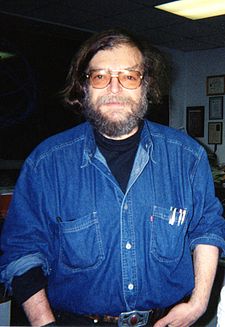- Nadrian Seeman
-
Nadrian C. Seeman 
Fields Nanotechnology, Crystallography Institutions New York University Alma mater University of Chicago, University of Pittsburgh Known for DNA nanotechnology  The M. C. Escher woodcut Depth (pictured) inspired Nadrian Seeman to consider using three-dimensional lattices of DNA to orient hard-to-crystallize molecules. This led to the beginning of the field of DNA nanotechnology.
The M. C. Escher woodcut Depth (pictured) inspired Nadrian Seeman to consider using three-dimensional lattices of DNA to orient hard-to-crystallize molecules. This led to the beginning of the field of DNA nanotechnology.
Nadrian C. "Ned" Seeman is an American nanotechnologist and crystallographer known for inventing the field of DNA nanotechnology.[1][2]
Seeman studied biochemistry at the University of Chicago and crystallography at the University of Pittsburgh.[3] He became a faculty member at the State University of New York at Albany, and in 1988 moved to the Department of Chemistry at New York University.
He is most noted for his development of the concept of DNA nanotechnology beginning in the early 1980's.[1] In fall 1980, while at a campus pub, Seeman was inspired by the M. C. Escher woodcut Depth to realize that a three-dimensional lattice could be constructed from DNA. He realized that this could be used to orient target molecules, simplifying their crystallographic study by eliminating the difficult process of obtaining pure crystals.[4][5] In pursuit of this goal, Seeman's laboratory published the synthesis of the first three-dimensional nanoscale object, a cube made of DNA, in 1991. This work won the 1995 Feynman Prize in Nanotechnology.[6]
The concepts of DNA nanotechnology later found further applications in DNA computing,[7] DNA nanorobotics, and self-assembly of nanoelectronics.[8] He shared the Kavli Prize in Nanoscience 2010 with Donald Eigler “for their development of unprecedented methods to control matter on the nanoscale.”[8][9] The goal of demonstrating designed three-dimensional DNA crystals was achieved by Seeman in 2009, nearly thirty years after his original elucidation of the idea.
Notable publications
- Seeman, N (1982). "Nucleic acid junctions and lattices". Journal of Theoretical Biology 99 (2): 237. doi:10.1016/0022-5193(82)90002-9. PMID 6188926.—An early paper outlining the concepts of DNA nanotechnology
- Chen, Junghuei; Seeman, Nadrian C. (1991). "Synthesis from DNA of a molecule with the connectivity of a cube". Nature 350 (6319): 631. doi:10.1038/350631a0. PMID 2017259.—The synthesis of the DNA cube
- Winfree, Erik; Liu, Furong; Wenzler, Lisa A. & Seeman, Nadrian C. (6 August 1998). "Design and self-assembly of two-dimensional DNA crystals". Nature 394 (6693): 529–544. doi:10.1038/28998. ISSN 0028-0836. PMID 9707114.—The synthesis of two-dimensional periodic lattices of double crossover molecules
- Mao, Chengde; Sun, Weiqiong; Shen, Zhiyong & Seeman, Nadrian C. (14 January 1999). "A DNA Nanomechanical Device Based on the B-Z Transition". Nature 397 (6715): 144–146. doi:10.1038/16437. ISSN 0028-0836. PMID 9923675.—The first DNA-based nanomechanical device
- Seeman, Nadrian C. (June 2004). "Nanotechnology and the double helix". Scientific American 290 (6): 64–75. doi:10.1038/scientificamerican0604-64. PMID 15195395. http://www.scientificamerican.com/article.cfm?id=nanotechnology-and-the-do.—A popular science article explaining the field of DNA nanotechnology
- Zheng, Jianping; Birktoft, Jens J.; Chen, Yi; Wang, Tong; Sha, Ruojie; Constantinou, Pamela E.; Ginell, Stephan L.; Mao, Chengde et al. (2009). "From molecular to macroscopic via the rational design of a self-assembled 3D DNA crystal". Nature 461 (7260): 74. doi:10.1038/nature08274. PMC 2764300. PMID 19727196. http://www.pubmedcentral.nih.gov/articlerender.fcgi?tool=pmcentrez&artid=2764300.—The synthesis of three-dimensional periodic lattices of tensegrity triangle molecules
- Gu, Hongzhou; Chao, Jie; Xiao, Shou-Jun; Seeman, Nadrian C. (2010). "A proximity-based programmable DNA nanoscale assembly line". Nature 465 (7295): 202. doi:10.1038/nature09026. PMC 2872101. PMID 20463734. http://www.pubmedcentral.nih.gov/articlerender.fcgi?tool=pmcentrez&artid=2872101.—A DNA-based molecular assembly line
See also
References
- ^ a b Pelesko, John A. (2007). Self-assembly: the science of things that put themselves together. New York: Chapman & Hall/CRC. pp. 201, 242, 259. ISBN 978 1 58488 687 7.
- ^ Dennis Overbye (3 June 2010). "8 Scientists Share $3 Million in Prizes". The New York Times. http://www.nytimes.com/2010/06/04/science/04kavli.html.
- ^ "Ned's Biography". Nadrian Seeman lab. http://seemanlab4.chem.nyu.edu/Seeman.html.
- ^ Seeman, Nadrian C. (June 2004). "Nanotechnology and the double helix". Scientific American 290 (6): 64–75. doi:10.1038/scientificamerican0604-64. PMID 15195395. http://www.scientificamerican.com/article.cfm?id=nanotechnology-and-the-do.
- ^ See Nadrian Seeman's homepage, Current crystallization protocol for a statement of the problem, and Nadrian Seeman's homepage, DNA cages containing oriented guests for the proposed solution.
- ^ "1995 Feynman Prize in Nanotechnology Awarded For Pioneering Synthesis of 3-D DNA Objects". The Foresight Institute. 30 November 1995. http://www.foresight.org/Updates/Update23/Update23.1.html#anchor415574.
- ^ Ng, W. D.; Wong, C. K. B. (2007). "Self-Recognition of DNA: From Life Processes to DNA Computation". Biophysical Reviews and Letters 2 (2): 123–137. doi:10.1142/S1793048007000490. PMID 20640192.
- ^ a b "NYU Chemist Seeman Wins Kavli Prize in Nanoscience". New York University. 3 June 2010. http://www.nyu.edu/about/news-publications/news/2010/06/03/nyu-chemist-seeman-wins-kavli-prize-in-nanoscience-.html.
- ^ "Names of the 2010 Kavli Prize winners announced". The Kavli Prize. http://www.kavliprize.no/nyheter/vis.html?tid=46747.
Categories:- Living people
- Crystallographers
- New York University faculty
- University of Chicago alumni
- University of Pittsburgh alumni
- DNA nanotechnology
Wikimedia Foundation. 2010.
